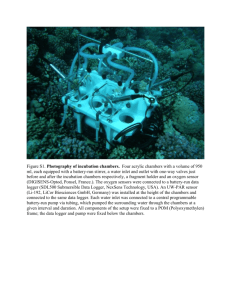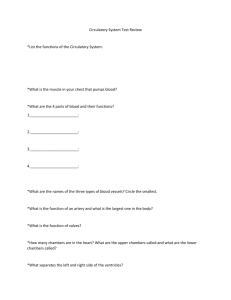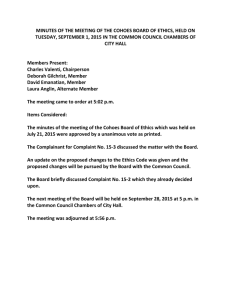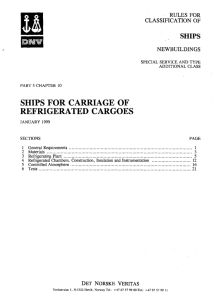Root screening in thin chambers
advertisement
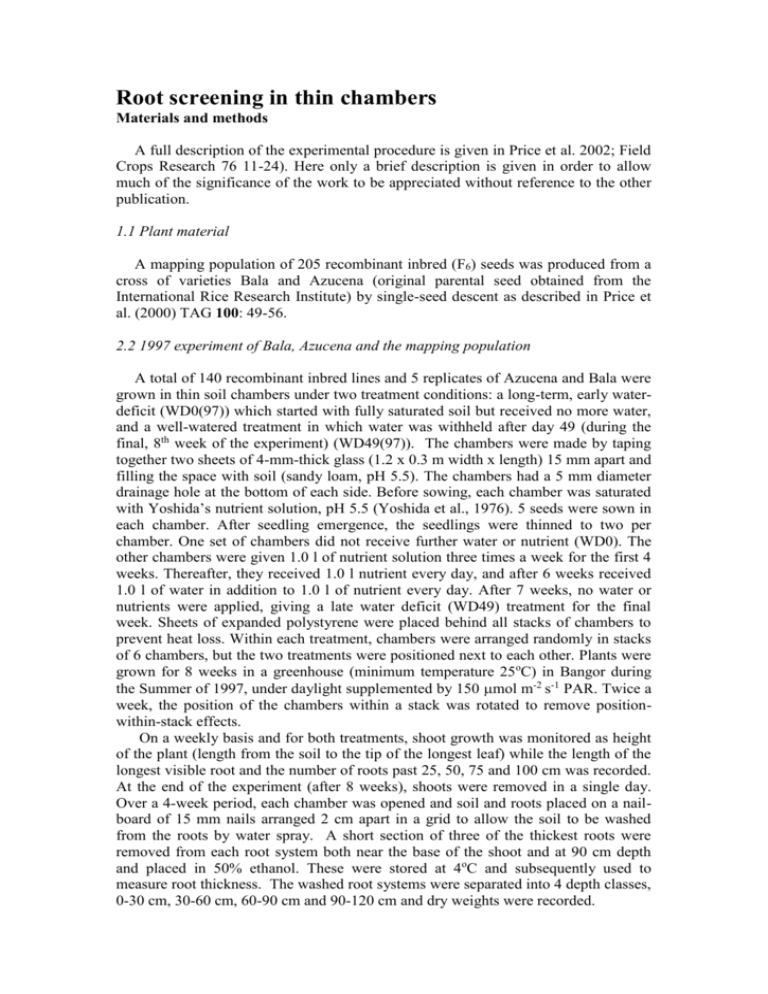
Root screening in thin chambers Materials and methods A full description of the experimental procedure is given in Price et al. 2002; Field Crops Research 76 11-24). Here only a brief description is given in order to allow much of the significance of the work to be appreciated without reference to the other publication. 1.1 Plant material A mapping population of 205 recombinant inbred (F6) seeds was produced from a cross of varieties Bala and Azucena (original parental seed obtained from the International Rice Research Institute) by single-seed descent as described in Price et al. (2000) TAG 100: 49-56. 2.2 1997 experiment of Bala, Azucena and the mapping population A total of 140 recombinant inbred lines and 5 replicates of Azucena and Bala were grown in thin soil chambers under two treatment conditions: a long-term, early waterdeficit (WD0(97)) which started with fully saturated soil but received no more water, and a well-watered treatment in which water was withheld after day 49 (during the final, 8th week of the experiment) (WD49(97)). The chambers were made by taping together two sheets of 4-mm-thick glass (1.2 x 0.3 m width x length) 15 mm apart and filling the space with soil (sandy loam, pH 5.5). The chambers had a 5 mm diameter drainage hole at the bottom of each side. Before sowing, each chamber was saturated with Yoshida’s nutrient solution, pH 5.5 (Yoshida et al., 1976). 5 seeds were sown in each chamber. After seedling emergence, the seedlings were thinned to two per chamber. One set of chambers did not receive further water or nutrient (WD0). The other chambers were given 1.0 l of nutrient solution three times a week for the first 4 weeks. Thereafter, they received 1.0 l nutrient every day, and after 6 weeks received 1.0 l of water in addition to 1.0 l of nutrient every day. After 7 weeks, no water or nutrients were applied, giving a late water deficit (WD49) treatment for the final week. Sheets of expanded polystyrene were placed behind all stacks of chambers to prevent heat loss. Within each treatment, chambers were arranged randomly in stacks of 6 chambers, but the two treatments were positioned next to each other. Plants were grown for 8 weeks in a greenhouse (minimum temperature 25oC) in Bangor during the Summer of 1997, under daylight supplemented by 150 mol m-2 s-1 PAR. Twice a week, the position of the chambers within a stack was rotated to remove positionwithin-stack effects. On a weekly basis and for both treatments, shoot growth was monitored as height of the plant (length from the soil to the tip of the longest leaf) while the length of the longest visible root and the number of roots past 25, 50, 75 and 100 cm was recorded. At the end of the experiment (after 8 weeks), shoots were removed in a single day. Over a 4-week period, each chamber was opened and soil and roots placed on a nailboard of 15 mm nails arranged 2 cm apart in a grid to allow the soil to be washed from the roots by water spray. A short section of three of the thickest roots were removed from each root system both near the base of the shoot and at 90 cm depth and placed in 50% ethanol. These were stored at 4oC and subsequently used to measure root thickness. The washed root systems were separated into 4 depth classes, 0-30 cm, 30-60 cm, 60-90 cm and 90-120 cm and dry weights were recorded. 2.3 1998 experiment of the mapping population The experiment was repeated in 1998 with minor modifications. Both early water deficit treatment (WD0(98)) and late water deficit treatment (WD49(98)) did not have small drainage holes at the bottom of the chambers. In the WD49(98) treatment the chambers received nutrient or water at a rate of only 800 ml per chamber. 2.4 Data handling Data was tested for normality before statistical analysis. The means of the both the parents and the F6 in 1997, and only the F6 in 1998 are presented in Table 1. Since there was no replication for the F6 and both treatment and year had a significant and interacting effect on most traits, it is not sensible to calculate broad-sense heritability based on F values from analysis of variance. Broad-sense heritablity was therefore calculated as 100 x (1 minus the ratio of the average variance of the non-segregating genotypes over the variance of the F6 population). These are presented in Table 2. In 1997, the non-segregating genotypes were Azucena and Bala. In 1998, they were Bala and 4 other Indian upland varieties that were included in the experiment (data not shown). Total plant mass was the sum of shoot and root dry weight after harvest on day 56. Root to shoot ratio was the root dry weight divided by the shoot dry weight. Maximum root length was calculated as the average of measurements of the longest visible root on days 28 and 35. All traits were normally distributed except for relative water content in 1997 for both WD0 and WD49 treatments, which were squared before analysis, and dry weight of root below 90 cm in WD49(97) and WD49(98), root thickness at both base and at 90 cm for WD0(98) and root to shoot ratio in all treatments, for which the square root was used for QTL analysis. QTLs were calculated for individual experiments and for the average of the two treatment types and for the overall average, in order to identify regions with a broad environmental stability from those that are perhaps environment specific. For calculating average values (and for visible root lengths for each experiment) data were first normalised by dividing the value for each individual by the population mean for that trait, before a mean was calculated.
